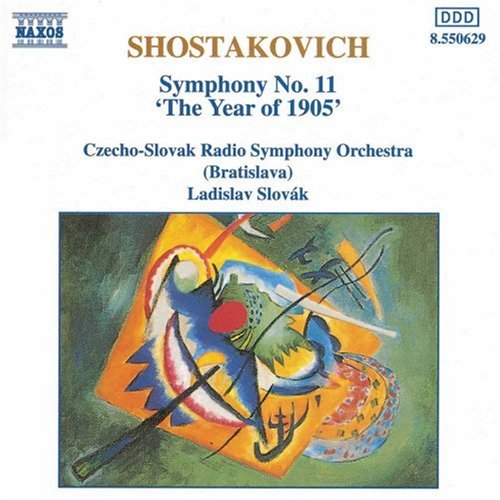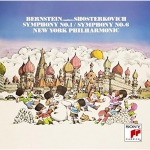Your search:
No selection
Filter results:
|
Other products from D. Shostakovich |
| Details / Tracklist: |
1.1 Sym No.11:The Palace Square1.2 Sym No.11: The 9th of January1.3 Sym No.11: In Memoriam1.4 Sym No.11: The Tocsin |
 | | Number of discs: |
1 |
 | | Description: | The Eleventh Symphony of Shostakovich was at one time seen abroad as mere Soviet propaganda, crudely cinematic programme music in support of Communism. With hindsight, colored by Volkov's Testimony, the work may be regarded very differently. At home it proved acceptable to the official musical establishment. In 1958 the composer was awarded the Lenin Prize and the Party condemnation of 1948 was withdrawn, attributed now to Stalinist excesses, under the malign influence of Molotov, Malenkov and Beria. The work is scored for a large orchestra, which includes xylophone, celesta, tubular bells and a possible four harps, in addition to the usual woodwind and brass and a suggested total of eighty string players. The somber first movement opens with muted strings and harps, followed by the entry of the timpani with a triplet rhythm figure and the Mahlerian sound of a muted trumpet fanfare. Into the texture he weaves two songs of nineteenth century political prisoners, Listen and The Prisoner. The second movement, introduced now by unmuted strings, brings the agitation and terror of the Cossack assault on the peaceful demonstrators, including here references to earlier compositions. In Memoriam mourns the victims of oppression, entrusted at first to the lower strings, and the composer continues to make use of themes popularly associated with the incidents of 1905 and the aspirations of the people. The last movement of a work that offers a vast canvas of historical and contemporary relevance, never descending to the level of a programmatic collage, has the title Nabat (Tocsin), a warning bell, the name of a review published by the exiled revolutionary Tkachev in Geneva, advocating violence in the cause of reform. The chosen title may be understood in a double sense in a movement that transcends the circumstances of it's composition. The Czecho-Slovak Radio Symphony Orchestra (Bratislava), the oldest symphonic ensemble in Slovakia, was founded in 1929. The orchestra's first conductor was Frantisek Dyk and over the past sixty years it has worked under the direction of several prominent Czech and Slovak conductors. The orchestra has made many recordings for the Naxos label ranging from the ballet music of Tchaikovsky to more modern works by composers such as Copland, Britten and Prokofiev. Ladislav Slovak was born in 1919 in the Slovak capital, Bratislava, where, in spite of straitened circumstances, he completed his earlier musical training at the City Music School and subsequently at the Bratislava Conservatory. As a conductor he was greatly influenced by Vaclav Talich in Bratislava and from 1954 by Yevgeni Mravinsky, to whom he served as assistant in Leningrad. For some two years Slovak attended Mravinsky's rehearsals with the Leningrad Philharmonic Orchestra of the symphonies of Shostakovich, including first performances of Symphonies Nos. 11 and 12. In these rehearsals Shostakovich was present, hearing his music in performance for the first time and rarely interfering, except for occasional adjustments of tempi. He had great confidence in Mravinsky, with whom there was collaboration at the profoundest musical level. Slovak was privileged often to take part in discussions on problems of performance between Mravinsky and Shostakovich, and also learned much from other conductors, including the second conductor of the Leningrad Philharmonic, Kurt Sanderling. On his return to Czecho-Slovakia Slovak was appointed Conductor-in-Chief of the Czecho-Slovak Radio Symphony Orchestra in Bratislava, with guest engagements with the Czech Philharmonic Orchestra, which he conducted on an extended world tour to the Far East, Australasia and Russia in 1959. In 1961 he was appointed Conductor-in-Chief of the Slovak Philharmonic Orchestra and has continued with similar appointments as far afield as Australia and with a busy career as a guest conductor. His early working collaboration with Mravinsky and Shostakovich has led to performances of particular authority, in particular of the latter's fifteen symphonies.? &© 1993. Made in U.S.A. Comes in a standard-size jewel case. 8pp fold-out booklet has notes in English. Tray inlay has a UPC-format barcode at lower right, with ?MADE IN U.S.A.? immediately above.
Cover art is credited to Jieyin Wang on the tray, but to Benjamin Chai on the back page of the booklet, and at Naxos.com (www.naxos.com/SharedFiles/pdf/rear/8.550629r.pdf#).
Recorded 25 April ? 4 May 1988 at the Concert Hall Of The Slovak Radio in Bratislava. |  | | No. of tracks: |
4 |
 | | Manufacturer No.: |
NXS8550629.2 |
 | Product Safety
Responsible Person for the EU:
Ten Dance Media GmbH
Boxhagener Str. 106, 10245 Berlin, DE
gpsr@tendance.de |  |
|
There are currently no product reviews.
|  |
|
|
 |
|



![D. Shostakovich - Shopworn Angel [US-Version, Regio 1]](https://img.grooves.land/images/cover/769/126/ts9k3uqa.j11)






















